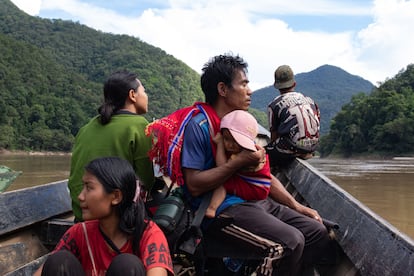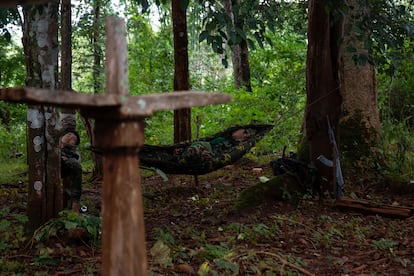May Phaw’s dangerous escape from Myanmar: ‘I have a son to save’
Civilians displaced by the Southeast Asian country’s three-year civil war face a journey through jungles, mountains and rivers to flee the violence

A large group of 40 treks through the jungles of Myanmar (formerly Burma), their feet blistered, carrying a single backpack with their meager possessions and a kilo of rice to sustain them on their arduous journey to the Thai border. Among them are pregnant women, young students and parents cradling infants only a few months old. They have chosen to risk everything in a bid to escape the brutal violence plaguing their homeland, seeking a fresh start across the border in Thailand.
Thousands have navigated these paths over the past three years, stemming from the resurgence of Myanmar’s enduring armed conflict following a coup in February 2021. The hope for a democratic shift was shattered as the military seized power, sparking widespread protests met with brutal suppression. An opposition coalition of guerrillas from ethnic minorities and pro-democracy factions united against the military junta. By October 2023, the conflict intensified, driving over 300,000 Burmese from their homes. The United Nations reports that over two million people have been displaced by the civil war, with many stranded in makeshift camps within the country, vulnerable to artillery attacks and completely lacking any humanitarian aid.
Driven by the fear of perishing in the crossfire and fueled by the hope of fleeing the world’s longest-running armed conflict, some venture on a perilous odyssey across rivers and mountains, enduring the relentless monsoon rains and the menace of the junta’s aircraft overhead. This is their story.

December 2023. May Phaw (a pseudonym) wakes her three-year-old at 4 a.m. Her husband packs the mosquito net and refills two bottles with freshly boiled water. They’ve been on the road for a week since leaving their town in northern Shan state to join other migrants at the foot of the Dawna mountain range in Karenni state, eastern Myanmar. They spent the night at the edge of a refugee camp, the last one before heading into the jungle for a challenging climb through remote mountains, far from any town. May Phaw is 31 years old and facing the dangers of the jungle for the first time in her life. “My biggest fear is something happening to my son. I worry about snake bites and malaria. But staying at home was worse. The army bombed our neighborhood daily in retaliation for guerrilla attacks,” she said sadly. She has left behind a life shattered by war — the Baptist church where she worked was destroyed in one of the bombings.
The group sets out before dawn to get ahead of the sun, led by a dozen soldiers from the Karenni guerillas, one of the armed groups fighting Myanmar’s military junta. A Karenni commander has agreed to guide the civilians through the mountains. They pause in a clearing after four hours of climbing, 1,000 meters above where they began. As the rice for lunch cooks over small campfires, the soldiers and civilians gaze at the sea of clouds below. The entire Karenni state is shrouded in a veil of mist. The group quickly dissolves into the jungle as the drone of a military plane disrupts their brief rest stop. They navigate through mountainous terrain with dense vegetation and into a swamp where a cloud of insects assaults them.
Some of the mountain trails are now blocked by landslides, so the group must hack new paths through the jungle with machetes
After descending to the Salween River at midday, everyone waits as the guerrillas try to contact the opposite shore by radio. The brown, muddy river flows swiftly, engorged by recent rains. Soon, a 25-foot boat piloted by two Karenni guerillas arrives to ferry the travelers across. After two 30-minute trips across the misty river, the group gathers on a deserted beach and begins walking again.
Three hours later, the refugees encounter some abandoned shelters engulfed by the relentless jungle growth. The first to arrive repair the roofs of two bamboo huts where families with children will sleep. The rest will sleep in hammocks covered by plastic tarps to shield themselves from the nighttime rains. The sun fades quickly and the only light comes from lanterns and bonfires used to dry clothes and boil water. The journey’s first day spanned 18 hours, with three more days of travel remaining until they reach their destination.
As the second day dawns, May Phaw checks the chafing on her shoulders from the cloth straps she uses to carry her son. Despite sharing the load with her husband, her skin has been rubbed raw. A Karenni soldier offers to carry their backpacks so they can focus on the child. Meals consist of cooked rice, dried fish and foraged vegetables. Electrolyte powders are added to boiled water to replenish the minerals lost through perspiration. Leaving the camp, they discard useless, muddy clothing along the trail.
The weeds, overgrown from all the rain, have obscured all signs of the path. Some of the mountain trails are now blocked by landslides, so the group must hack new paths through the jungle with machetes. The ascents have also turned treacherous, the mud causing frequent slips. At times, a sharp cry pierces the air — a signal that someone has stumbled, pushing crumbling rocks down on the people below. Sometimes, the cries are a plea for help to stop someone from sliding down the slope.

On the third and fourth days, the group traverses numerous tributaries of the Salween. It’s the quickest way through the mountains, but entails wading through waist-deep water all day, often battling strong currents. At sunset on the third day, thunder echoes through the river canyon. The monsoon is upon them and heavy rain begins to fall. The water level rises six feet in 10 minutes, uprooting trees from the riverbank. One civilian struggles to climb high enough in time and calls for help. Soldiers form a human chain to rescue him from a log before he’s swept away by the water. Separated at different places along the canyon, everyone waits patiently for the water to subside. May Phaw’s husband wraps their son in several layers of plastic, trying to keep him dry while she checks their remaining supplies.
Just before dusk on the fourth day, Do No Ku comes into view — a refugee camp near the border with Thailand. Faces light up as the group descends into the valley, leaving the jungle behind to find themselves surrounded by corn and rice fields. The scent of jasmine from the Karenni gardens welcomes them before they reach the first bamboo huts, where people await their arrival. They have reached their destination, and many reunite with relatives and friends.
Thailand’s policy on political asylum is clear — there is none
As they tend to their wounds and weather-worn clothes, the newcomers are cautioned by earlier arrivals that the neighboring country does not take in refugees. Thailand’s policy on political asylum is clear — there is none. If they cross, they will be considered illegal immigrants and could face persecution from the authorities. Recently, Thai officials have ordered them to move away from the border and increased security. Despite being so close to Thailand, the displaced people are still at risk — the camp school was bombed and burned down months ago by a military fighter plane.
Faced with the border closure, the new arrivals ponder their future. The announcement of a border security pact between Myanmar’s military junta and Thai authorities complicates matters. Some think about staying in Do No Ku despite the danger of bombings. Others decide to go back to their villages along the treacherous jungle paths. The braver ones with more resources explore fleeing to other neighboring countries, but nowhere is safe along Myanmar’s borders.
In the north, around 30,000 Burmese refugees were sent back by Chinese authorities last November. To the west, refugees in camps in Bangladesh also face involuntary repatriation. Two million displaced people are caught in the middle of the civil war, with violence pushing them in one direction and Myanmar’s neighbors pushing them in another. Their human rights — so clear and elegant on paper — are as useless as their ragged, rain-soaked clothes.
For May Phaw’s family there is no turning back and no money to press forward. She checks messages on her cell phone and learns that their house has been destroyed in the fighting. Her eyes tear up as she views photos sent by a neighbor that show a sofa in a pile of rubble and charred wood, the sole remnants of their home. Nevertheless, she does not succumb to despair. “I can’t afford to,” she said firmly. “I know we’ll get out of here — I have a son to save.”
Sign up for our weekly newsletter to get more English-language news coverage from EL PAÍS USA Edition
Tu suscripción se está usando en otro dispositivo
¿Quieres añadir otro usuario a tu suscripción?
Si continúas leyendo en este dispositivo, no se podrá leer en el otro.
FlechaTu suscripción se está usando en otro dispositivo y solo puedes acceder a EL PAÍS desde un dispositivo a la vez.
Si quieres compartir tu cuenta, cambia tu suscripción a la modalidad Premium, así podrás añadir otro usuario. Cada uno accederá con su propia cuenta de email, lo que os permitirá personalizar vuestra experiencia en EL PAÍS.
¿Tienes una suscripción de empresa? Accede aquí para contratar más cuentas.
En el caso de no saber quién está usando tu cuenta, te recomendamos cambiar tu contraseña aquí.
Si decides continuar compartiendo tu cuenta, este mensaje se mostrará en tu dispositivo y en el de la otra persona que está usando tu cuenta de forma indefinida, afectando a tu experiencia de lectura. Puedes consultar aquí los términos y condiciones de la suscripción digital.
More information
Archived In
Últimas noticias
The complicated life of Francesca Albanese: A rising figure in Italy but barred from every bank by Trump’s sanctions
How Japan is trying to avert ‘digital defeat’
Half of Scotland is in the hands of 420 property owners
Reinhard Genzel, Nobel laureate in physics: ‘One-minute videos will never give you the truth’
Most viewed
- Pablo Escobar’s hippos: A serious environmental problem, 40 years on
- Reinhard Genzel, Nobel laureate in physics: ‘One-minute videos will never give you the truth’
- Why we lost the habit of sleeping in two segments and how that changed our sense of time
- Charles Dubouloz, mountaineering star, retires at 36 with a farewell tour inspired by Walter Bonatti
- The Florida Keys tourist paradise is besieged by immigration agents: ‘We’ve never seen anything like this’










































